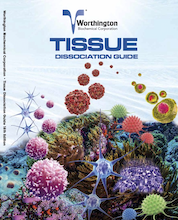For our international customers, please be advised that orders cannot be placed through our website by customers in countries with International Distributor representation.
Worthington Tissue Dissociation Guide
Dissociating Enzymes: Elastase
Pancreatic elastase is a serine protease with a specificity for peptide bonds adjacent to neutral amino acids. It also exhibits esterase and amidase activity. While elastase will hydrolyze a wide variety of protein substrates, it is unique among proteases in its ability to hydrolyze native elastin, a substrate not attacked by trypsin, chymotrypsin or pepsin. It is produced in the pancreas as an inactive zymogen, proelastase, and activated in the duodenum by trypsin. Elastase is also found in blood components and bacteria.
Because elastin is found in highest concentrations in the elastic fibers of connective tissues, elastase is frequently used to dissociate tissues which contain extensive intercellular fiber networks. For this purpose, it is usually used with other enzymes such as collagenase, trypsin, and chymotrypsin. Elastase is the enzyme of choice for the isolation of Type II cells from the lung.
Tissue Tables
The Worthington Tissue Tables provide references useful to researchers interested in tissue dissociation and cell harvesting procedures. The references are organized by Tissue and Species type and linked to PubMed citations. The Cell type, Enzymes, and Medium for each reference is provided.
To search by specific criteria, use the Tissue References Search Tool.
